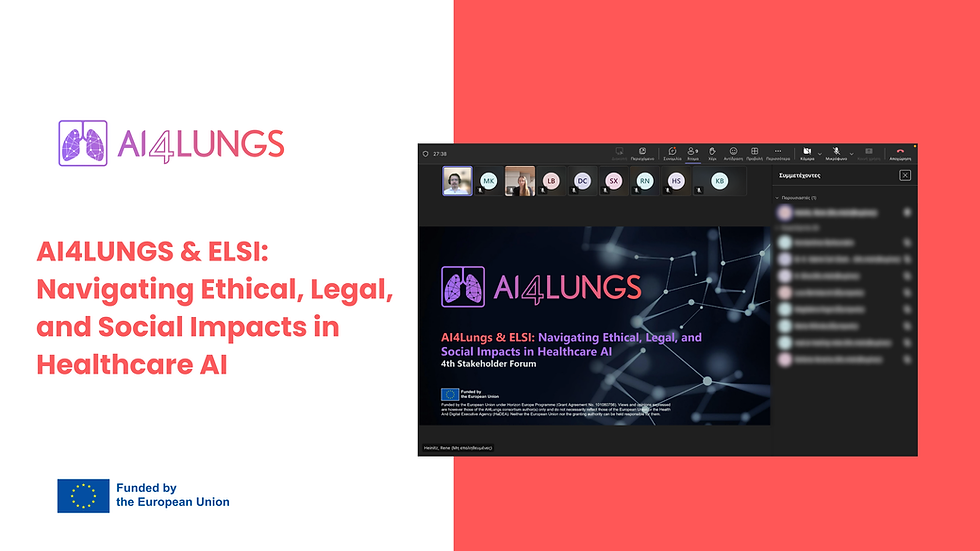EU AI Act- What is it and what role does it play for AI4LUNGS?
- AI4LUNGS

- May 26
- 3 min read
Magdalena Kogut and Marta Wilinska from Timelex, AI4LUNGS’ legal partner, hosted the EU Artificial Intelligence Act Training for the consortium partners. As a project tightly connected to AI technology, it is crucial to educate and inform partners from AI4LUNGS with the latest AI act and regulations to be sure the AI use is compliant to the EU AI Act.
What is the AI Act?
AI Act, abbreviated as AIA, entered into force on 1st of August 2024. As an EU regulation, it is binding in its entirety and directly applicable in all Member States. The aim is to promote the uptake of human-centric and trustworthy artificial intelligence on the EU market; and to ensure a high level of protection of health, safety, and fundamental rights.
Who does the AI Act apply to?
The AIA applies to anyone deploying, developing, or distributing AI systems in the EU, including:
Deployers: Those using AI systems within the EU or in the third country whose output affects individuals in the EU.
Providers: Entities developing AI systems for use in the EU, even if based in third countries.
Representatives: EU-based entities representing a provider from outside the EU.
However, there are some exceptions for scientific research…
Research and the AI Act: What Applies and What Doesn’t
Under the EU AI Act, AI systems developed and used solely for scientific research and development are not subject to the regulation. This includes any research, testing, or development activities prior to an AI system being placed on the market or put into service. These activities, however, must be conducted in line with recognised ethical and professional scientific standards, as well as applicable Union law.
That said, the exemption ends when an AI system is placed on the market or used in real-world conditions—such as through AI regulatory or other forms of live testing. This distinction is highly relevant to AI4LUNGS. While the AI models developed in the project are currently in the research and development phase, the final goal is to deploy these tools in clinical settings. AI4LUNGS aims to create a platform that supports clinical decision-making, offering clinicians a second-opinion system that interprets patient data, explains diagnostic outcomes, and assists in optimising treatment options for respiratory diseases.
Given this trajectory, consortium partners must assess whether the systems they are developing meet the definition of an AI system under the AIA, and if so, under which risk classification they fall. It is equally important to identify the roles partners play—whether as providers, deployers, or manufacturers—and to consider factors such as:
Whether the AI tool is also a medical device, requiring MDR conformity assessment;
If the system is classified as High-Risk AI based on its intended use;
And whether the system will require compliance with AIA obligations if it is brought to market after the end of the project.
To minimise future compliance burdens, developers within AI4LUNGS are encouraged to incorporate AIA requirements from the beginning, especially in areas such as data governance, transparency, human oversight, logging, and cybersecurity.
AI meets Healthcare
As the AI4LUNGS project progresses, staying aligned with the EU AI Act is essential not only for legal compliance but also for building trustworthy, clinically relevant AI systems. By understanding the regulatory landscape early on, the consortium can ensure a smoother transition from research to real-world application—ultimately helping to deliver innovative, safe, and ethical AI solutions in respiratory healthcare.
Stay updated on the AI4LUNGS research development and progress by following the project on BlueSky, X and LinkedIn, and subscribing to our newsletter for the latest insights and advancements.






